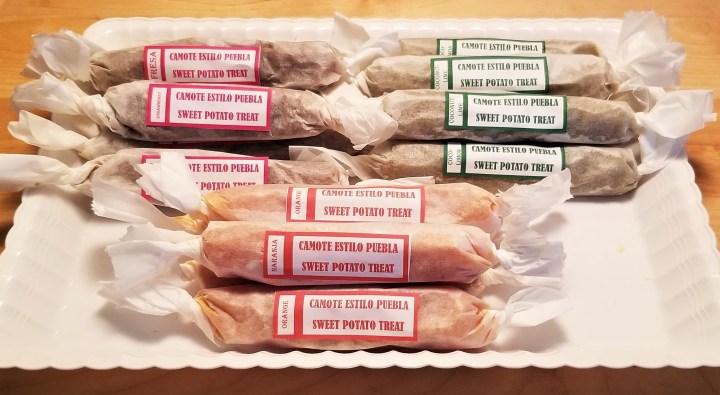
The Mexican state of Puebla has one of the richest cuisines in the country, recognized for iconic dishes such as mole Poblano (Puebla Style red mole), or chiles en nogada (stuffed poblano peppers in walnut sauce), particularly popular during the month of September, to commemorate Mexico’s Independence. There are also many sweet preparations, and the traditional treat to bring back home after a visit to Puebla, is a box of flavoured sweet potato bars (as pictured at the top of this post), lovingly wrapped in paper, and available at every confectionery store in the state:

They are so well known in Mexico that they are simply called “camotes de Puebla” – “sweet potatoes from Puebla”, and it is implied that refers to the prepared sweets, not the vegetable roots. I would never have thought of making them while in Mexico, but now that I live in Canada, I felt I had to try. They are easy to prepare, with just a simple syrup and flavourings added to cooked and mashed sweet potatoes. Traditionally, all flavourings added were natural: lime, strawberry, orange, coconut, pineapple, vanilla, etc.; more recent recipes call for artificial flavourings, and food colouring to mask the natural tone of cooked sweet potato, so making them at home is a good way to avoid those antics, as well.
Puebla Style Sweet Potato Treats –
Camotes de Puebla
Ingredients (for one dozen)
2 large sweet potatoes (preferably white-fleshed, approximately 400 g each); thoroughly washed
1 ½ cups granulated sugar (approximately 300 g)
½ cup water (250 ml)
Choice of flavouring (quantities for one batch):
½ cup strained strawberry or other fruit jam OR
½ cup shredded dry coconut OR
2 tbsp orange blossom water, or orange zest, or lime zest, or vanilla extract or rose water, etc.
Powdered sugar, for coating
Parchment paper, labels, glue stick
I found some good sized white-fleshed sweet potatoes (sometimes called Japanese yams in Canada). They are dark pink, almost purple on the outside, and white inside:

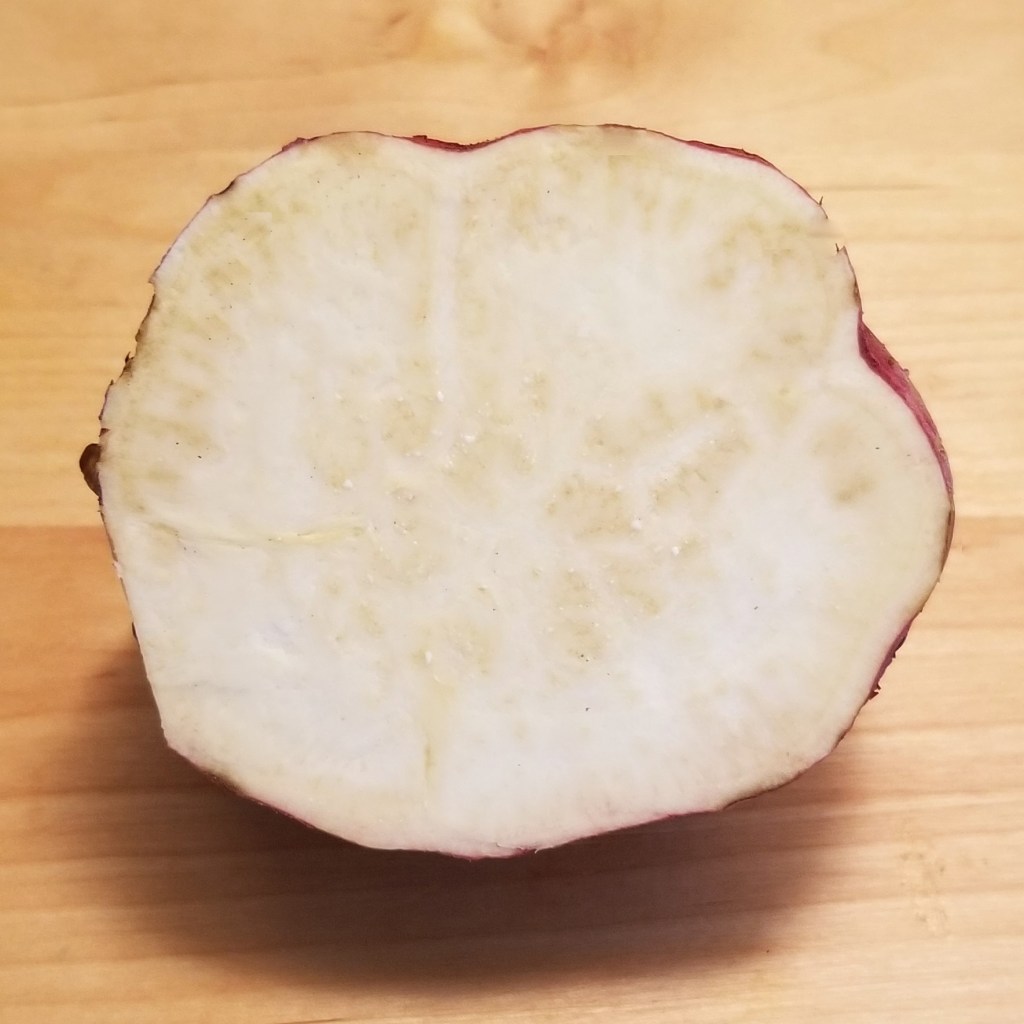
They start to discolour as soon as they are sliced, so first set up a large pot with water, then peel and cut the sweet potatoes into large chunks, quickly placing them in the water (photo below, left). Cook over high heat, covered, until tender when tested with a fork; mine took twenty minutes. Remove pot from heat, drain water, and mash sweet potatoes (photo below, right):

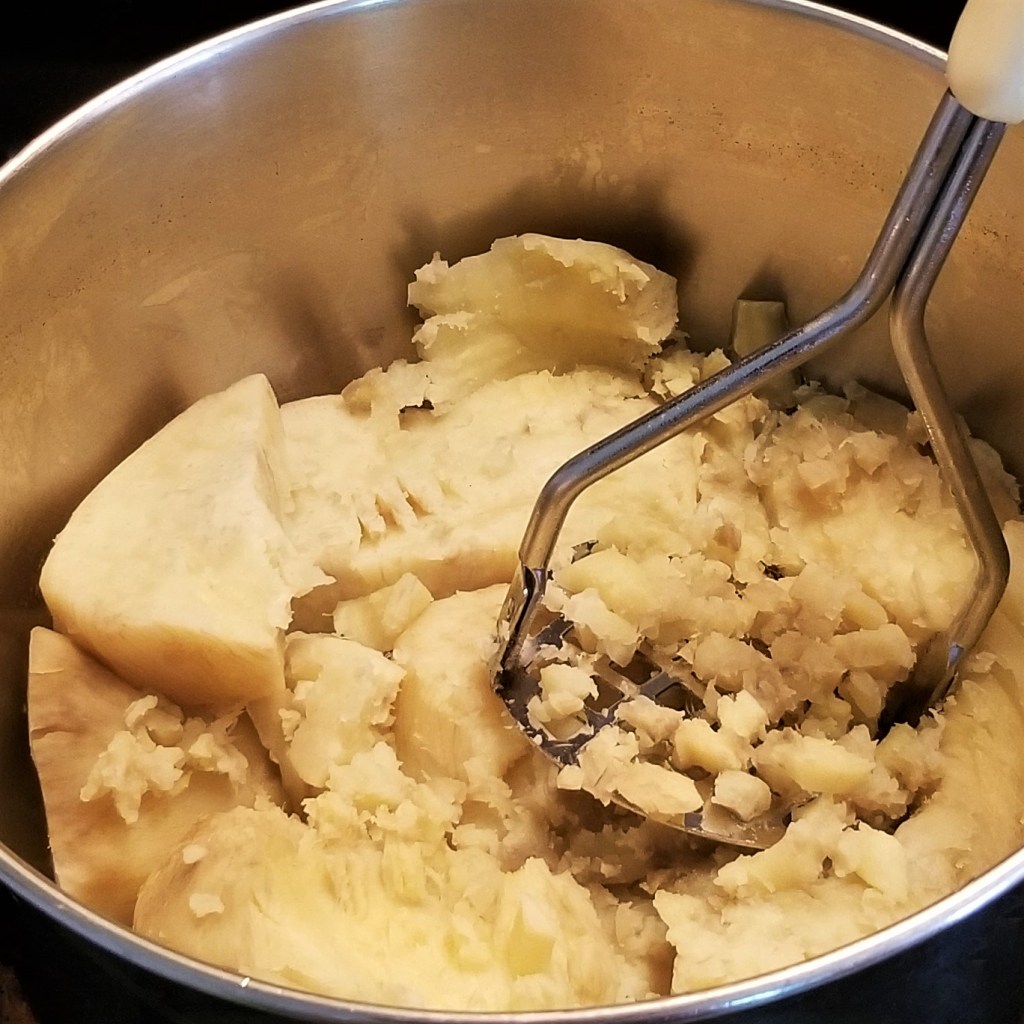
I got about 600g of cooked sweet potato mash. The recommended amount of sugar for some recipes goes from as high as equal weight, down to half, and that is what I chose, so 300 g for this batch. At this point, the mashed sweet potato might be divided into smaller batches, if several flavourings are to be used. I decided to try with two half-batches, so I placed 150g of granulated sugar (about 3/4 cup) and 1/4 cup of water in a small pan over medium heat (photo below, left). The mix has to be stirred to dissolve sugar, and cooked until it becomes bubbly and thickens into a syrup (photo below, right):

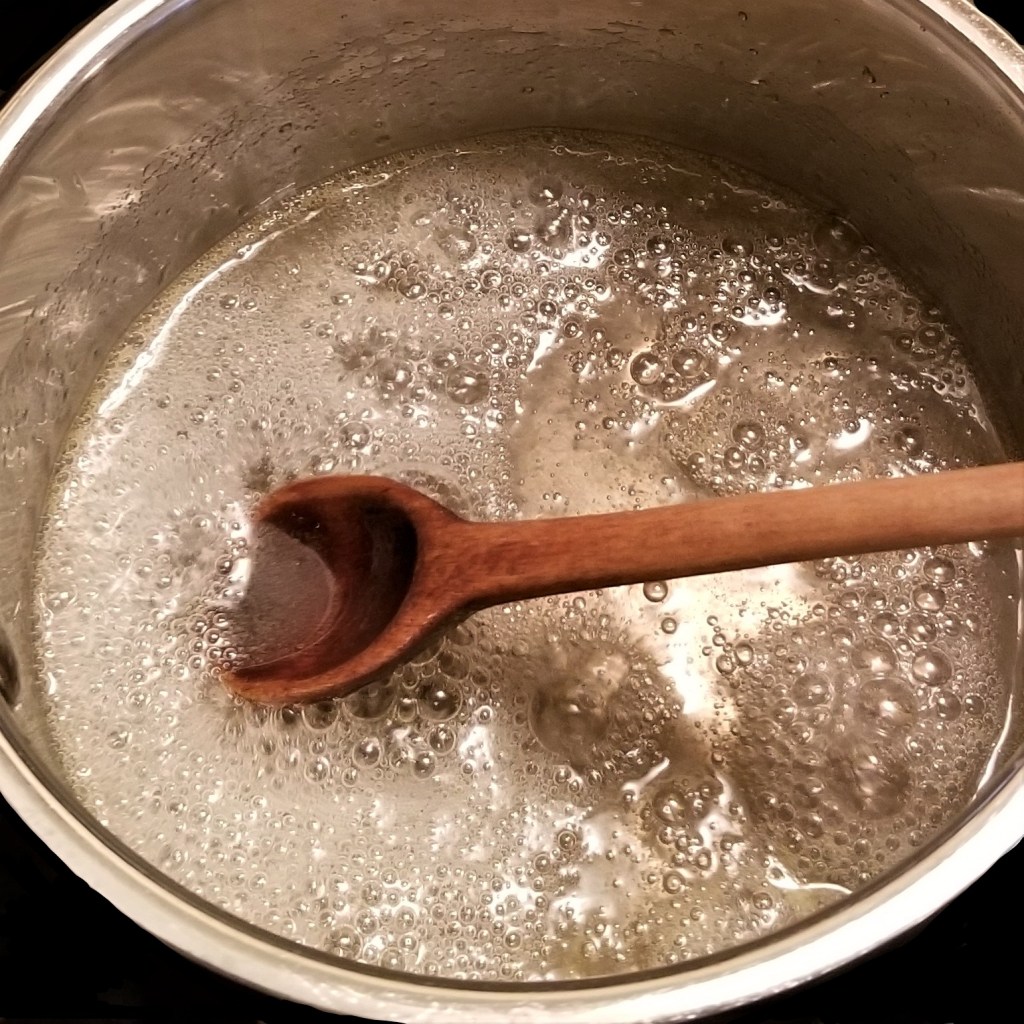
Incorporate flavouring of choice; I added 1/4 cup dry shredded coconut (photo below, left). Add reserved mashed sweet potatoes (in this case half), and continue cooking and stirring, to thicken the paste (photo below, right):

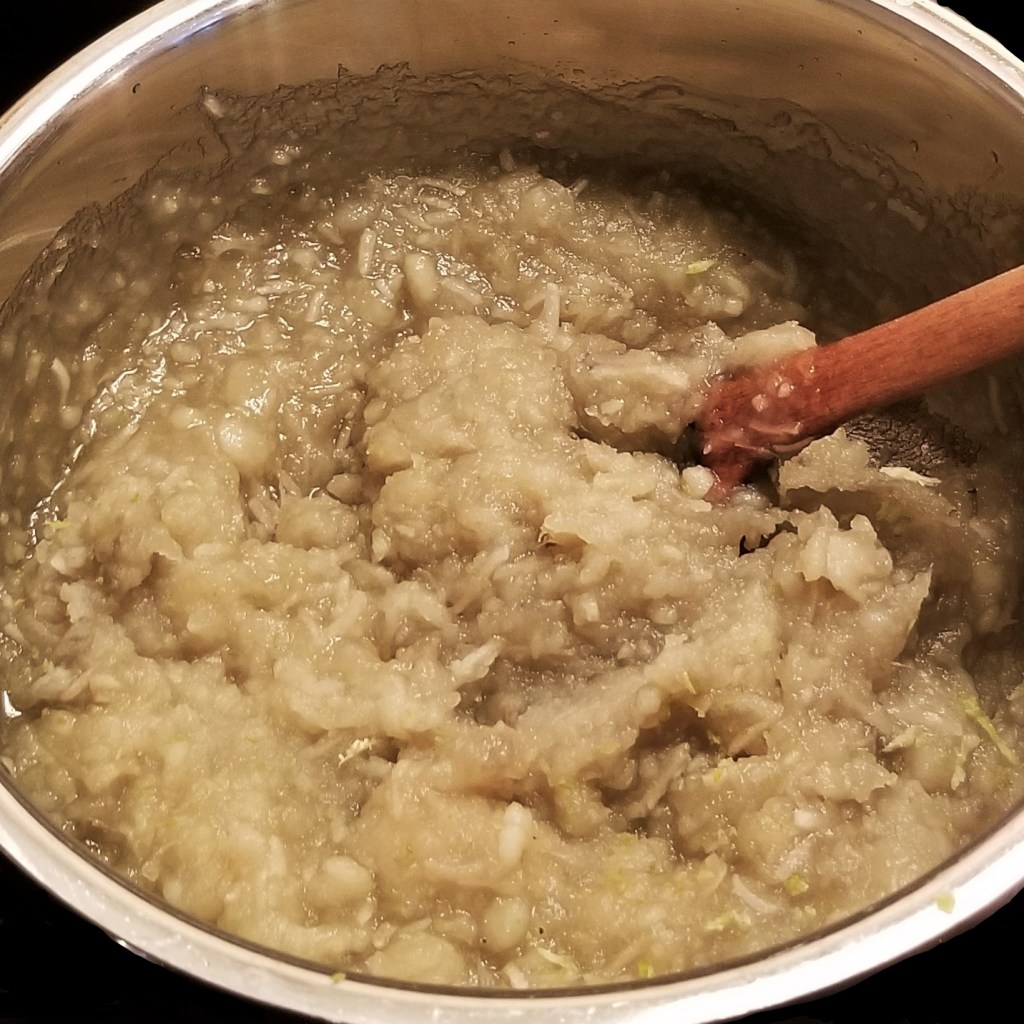
The paste is ready when it looks dry and the bottom of the pan shows when the paste is stirred with the spoon, approximately 12 minutes for this amount. Since the sweet potato gave the paste an off-white shade, I added 1 tsp of grated lime zest, and the paste turned greenish (photo below, right):
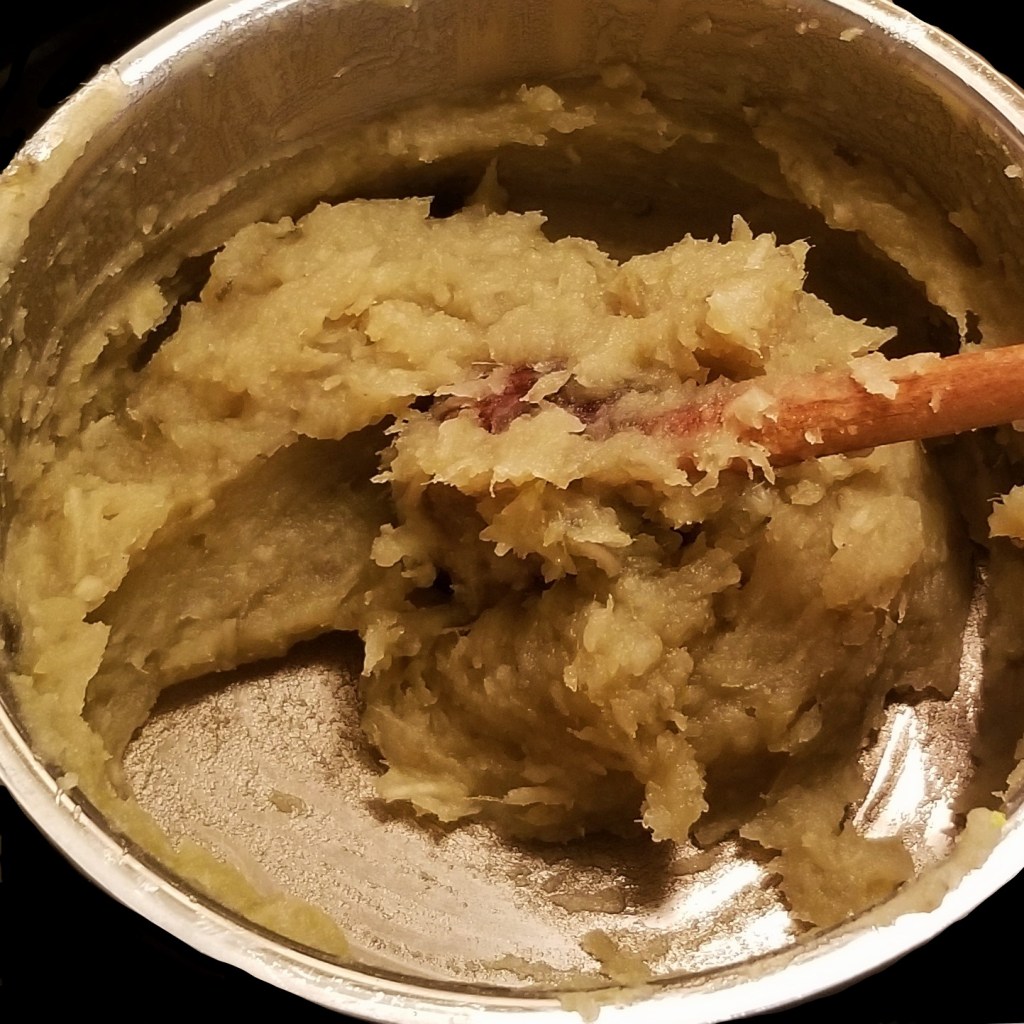
Transfer to a bowl and allow to completely cool down to room temperature.
For the other half batch, I chose strawberry flavour, so I strained some jam to obtain 1/4 cup of smooth strawberry “sauce” (photo below, left). I cleaned the small pan and repeated the procedure, preparing the clear syrup with another 3/4 cup of sugar and 1/4 cup water, then adding the strained strawberry jam (photo below, right):

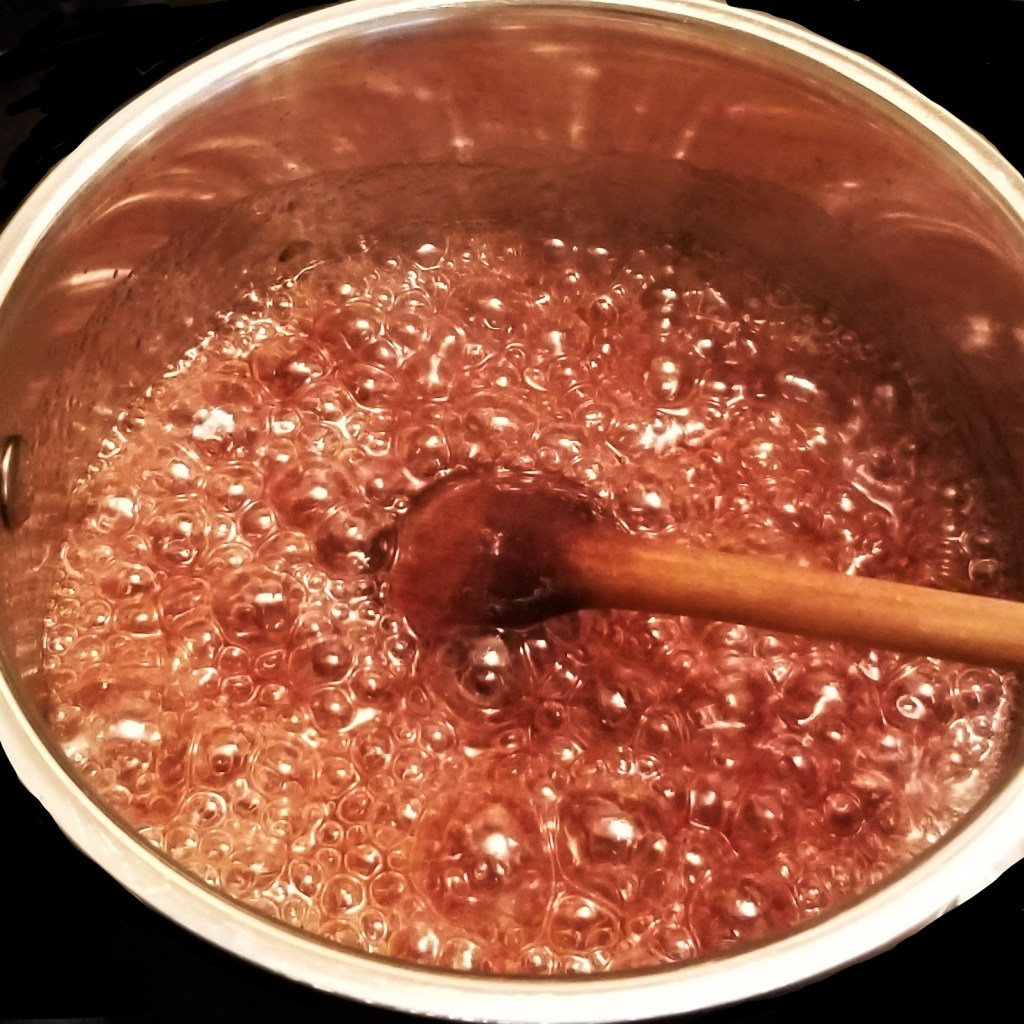
I added the remaining half of the sweet potato mash, and stirred and cooked until thick as before. For this flavour and quantities, it took about 15 minutes, a little longer than with the dry coconut. I transferred to a bowl and allowed to cool as before.
This paste turned a muddy pink, mostly brown coloured, very close to old-fashioned version for this flavour. I wanted to make some orange paste, and I thought that, just in this case, using orange-fleshed sweet potato might work nicely. I cooked and mashed a large one (this take a little shorter than the white-fleshed), then cleaned the small pan and started a third small batch of syrup. For flavouring, I added one tablespoon of orange blossom water (photo below, left). I added the sweet potato mash, and continued cooking (photo below, right):


Orange-fleshed sweet potatoes have a higher water content compared to white-fleshed ones, so this batch took close to 20 minutes to thicken. The colour, though, was a very bright orange, so I thought it was worthwhile taking the extra time.
Once all the flavours have cooled down, I prepared a tray with powdered sugar, and taking about 1/4 cup of paste at a time, formed cylinders about three inches (7.5 cm) long; I placed them on powdered sugar on the tray, then sprinkled with more powdered sugar, working with all the different pastes:

To wrap in parchment paper, I cut strips from a roll (15 inches wide), pulling out about 6 inches, cutting that strip into four pieces, and ending up with 6 in x3.75 in rectangles. Taking one treat, I placed it in the centre of the rectangle, then wrapped lengthwise, and twisted the ends:

I made labels copying the original design from Puebla (template included with printable recipe); glued to the wrappers, they identified each flavour properly:

The different flavours had different colours without artificial additives (photo below, left). They may be kept in a dry spot for a few days, or in the fridge for up to two weeks. they will develop a thin crystallized layer as they dry, as seen in the photo below, right, but that is tasty, too:

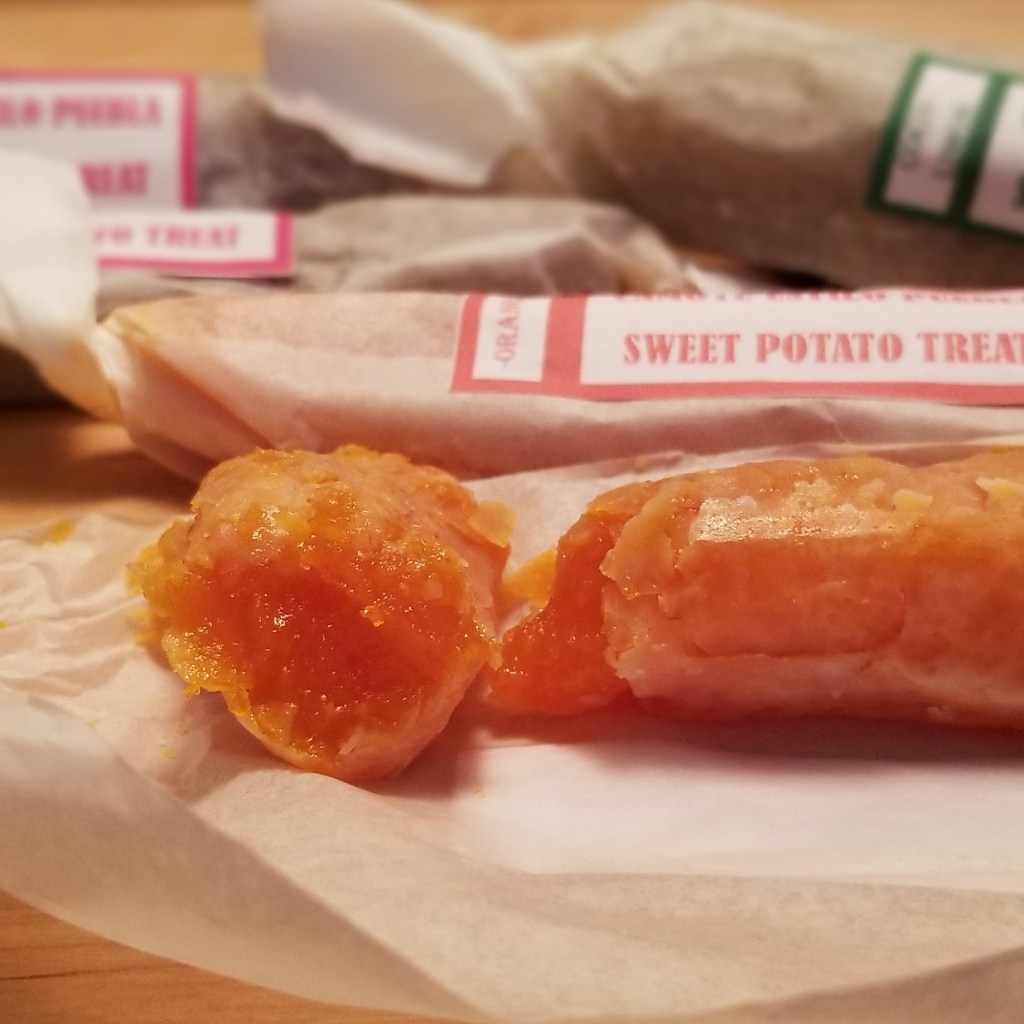
I am bringing my Puebla style sweet potato treats to Su’s Virtual Tea Party, Kia Ora, Su! Growing introspective, I was thinking of how much I am missing my daughters, currently working in France and Japan, so I thought it would be nice to have a café au lait or a green tea with these treats, especially when served in the University of Toronto mugs that each girl so fittingly gave me:
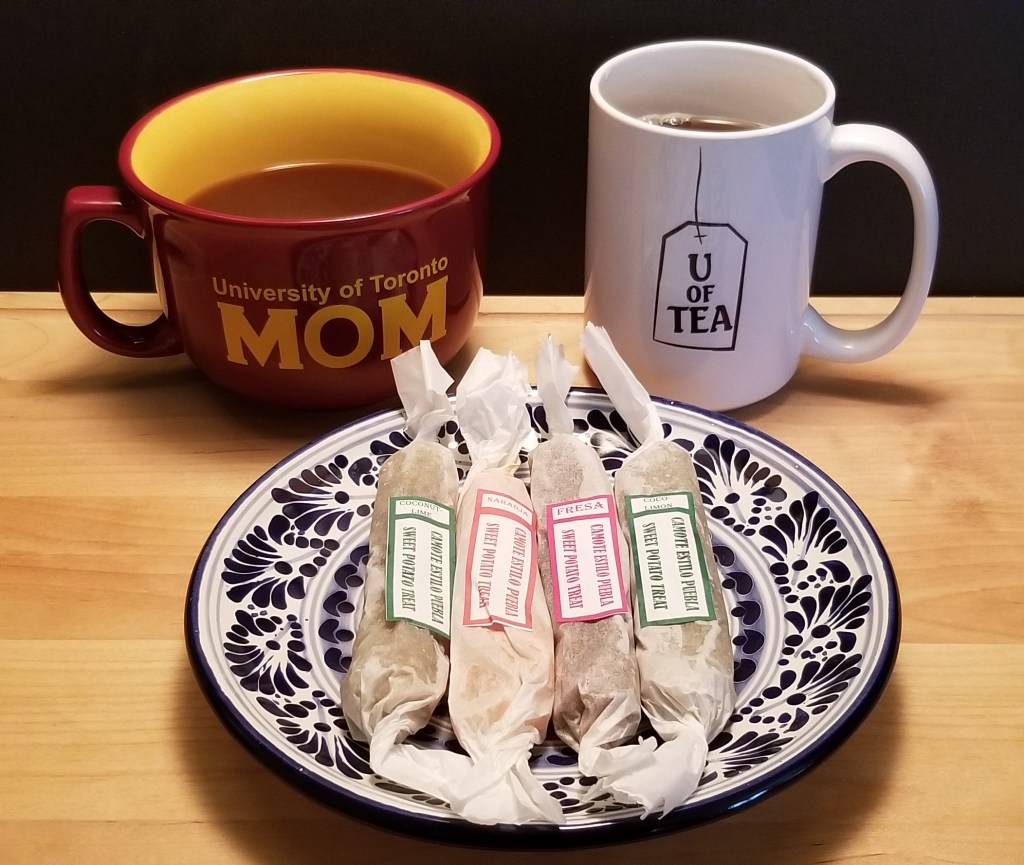
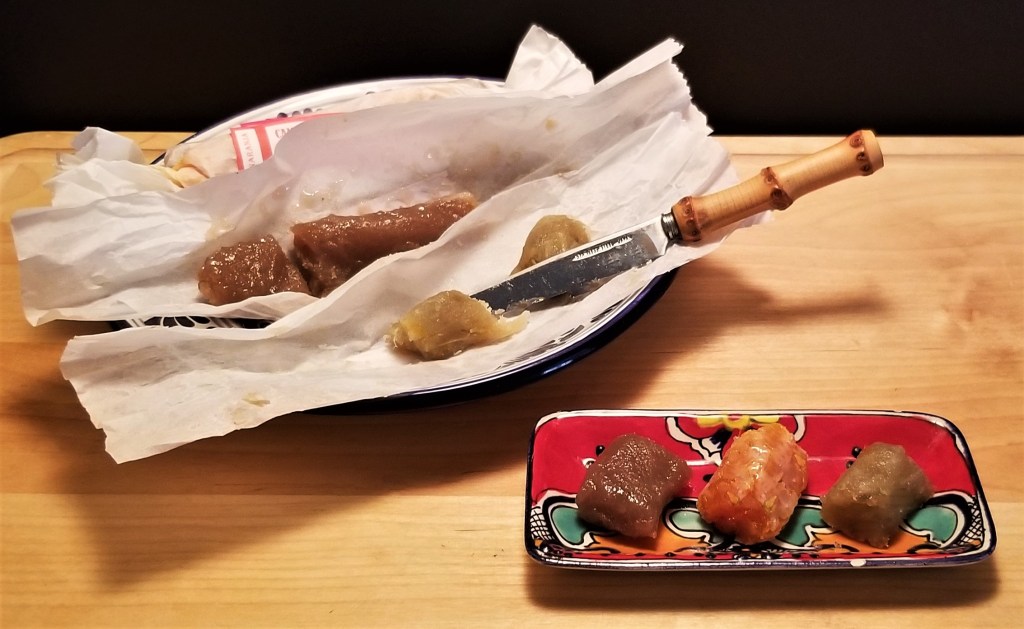
It was great to sample all the different flavours of camotes de Puebla, as shown above, in Mexican Talavera ceramic plates, another example of Puebla’s extensive cultural footprint (more on this in my next post.)
For your convenience, click on the images below for products available on Amazon™. DISCLAIMER: Any reviews included in this post are my own, for items I have purchased, not provided by any company; as an Amazon Associates Program affiliate, I might receive a commission for any purchases originated from the links below, at no extra cost to you:
I am bringing these traditional sweets to Fiesta Friday # 346 with Angie @ Fiesta Friday, this week co-hosting with Jhuls @ The Not So Creative Cook.
I am sharing my recipe at What’s for Dinner? Sunday Link-Up #281 with Helen @ The Lazy Gastronome. I was thrilled to see my Quesadillas from Corn Dough featured at this party; thank you Helen!
I am sharing my recipe at Over the Moon #243, graciously hosted by Bev @ Eclectic Red Barn, and Marilyn @ Marilyn’s Treats.
I am sharing my recipe at Thursday Favourite Things #458, with Bev @ Eclectic Red Barn, Pam @ An Artful Mom, Katherine @ Katherine’s Corner, Amber @ Follow the Yellow Brick Home, Theresa @ Shoestring Elegance and Linda @ Crafts a la Mode.
I am bringing my recipe to Full Plate Thursday #503 with Miz Helen @ Miz Helen’s Country Cottage.










They look so delicious! I bet this is a recipe with a long cultural history. Thanks for sharing it with us.
LikeLiked by 2 people
Like many dishes in Puebla, it all started in a convent during colonial times. Now they are ubiquitous all over the state.
LikeLiked by 1 person
I love sweet potatoes, though I haven’t tried to make sweets with them (I am seriously tempted). My mother used to love scottish macaroon bars, which are made with mashed potato mixed with confectioners sugar, dipped in chocolate and coated in coconut. Even as a child I found them terribly sweet, but that might have been that my siblings and I scoffed as much as possible quickly because Mum loved them so much that if we didn’t, there would be none left.
I haven’t seen white-fleshed sweet potato here, but will try using the orange-flesh. Do you think that roasting them first will solve the problem of their extra moisture?
Thank you so much for sharing both the treat and the recipe with everyone. I’m so glad you join the tea parties; it’s great to have your company and I learn so much.
YOur white/purple sweet potato looks like our kumara — brought here by the Polynesian settlers. They have a very dry yellow and purple-flecked flesh; excellent for moisture content I guess.
LikeLiked by 1 person
Those macaroon bars sound interesting; I remember a chef making marzipan with potatoes once on TV, sounds similar.
I think your red kumara is pretty much my white-fleshed sweet potato, from looking at internet pics . I don’t know what the effect of roasting would be, but just cooking longer takes care of extra water.
I am glad I found your parties, as well, it is so much fun, and I am learning a lot, too, thank you for hosting!
LikeLiked by 2 people
I might try roasting, and I’ll let you know.
LikeLiked by 1 person
Please do, thank you!
LikeLiked by 1 person
Do you happen to have a recipe for the cocadas or mueganos from Puebla?
Mi suegra nacio en Puebla y nosotros solíamos ir con frecuencia. Aunque regresé a Canadá, todavía hago su receta de tinga y extraño las cemitas.
LikeLike
Hi, Donna! I have a post on cocada: https://mysliceofmexico.ca/2020/02/14/traditional-sweets-cocada/ ; this is the dairy-free one, but if it is from Puebla, you might be thinking of the cocada de yema – egg yolk cocada. I have not published that recipe yet, but the traditional recipe goes like this: peel a coconut (check my post on how to open and peel a coconut https://mysliceofmexico.ca/2018/10/31/a-follow-up-halloween-story-no-axe-no-problem), shred the “meat” with a cheese grater and set aside. Separate 6 eggs, saving whites for another use; beat the 6 yolks until uniform and pale yellow, and set aside. Boil 4 cups of whole milk with 2 1/2 cups of granulated sugar, and cook, stirring, until thickened but not browned. Add shredded coconut and simmer for 30 minutes. Remove from heat, then slowly add the egg yolk paste, mixing with an egg beater, until everything comes together and the mixture looks like a custard. Pour into an 8x8inch mould and bake in a preheated oven at 350F until lightly golden, and bottom is golden brown. Let cool down and slice into rounds with a cookie cutter, or squares with a knife.
The mueganos from Puebla can be fried (little pillows of yeasty dough in syrup) or baked (from Tehuacan, more like a cookie sandwiched with thin wafers) which ones are you thinking of?
LikeLike
What an interesting concept Irene. I was wondering how you would weave footprint into the post 🙂 Thanks for joining in
LikeLike
😁👣
LikeLiked by 1 person
Hi Irene, I seem to remember something similar to this as a kid in NYC. I’ll have to make some and see if the taste is similar. Thanks!
LikeLike
Let me know how it goes, thanks, Lou!
LikeLiked by 1 person
These sound really good. Anything I can sneak a veggie in has my vote! I love sweet potatoes but haven’t tried the white fleshed ones. Your flavors sounds amazing ♥
*hugs*
deb
LikeLike
Thank you, Deb, I hope you get to try making these treats.
LikeLike
We love Sweet Potatoes here. Saving to make later!
********************************************************
Thank you for sharing at #OverTheMoon. Pinned and shared. Have a lovely week. I hope to see you at next week’s party too! Please stay safe and healthy. Come party with us at Over The Moon! Catapult your content Over The Moon! @marilyn_lesniak @EclecticRedBarn
********************************************************
LikeLike
Hope you like them; thank you, Marilyn, and thank you for hosting!
LikeLiked by 1 person
I want to eat 🤩😍❣️
LikeLiked by 2 people
Irene,
Once again I love to read your recipe stories and history. These look so yummy. I have never seen that sweet potato around here. Can you use regular ones?
Congratulations, you are being featured at Over The Moon Linky Party. https://www.eclecticredbarn.com/2020/09/over-moon-linky-party_27.html
Hugs,
Bev
LikeLiked by 2 people
Hi, Bev, thank you for the feature! One of the batches in my post was made with orange-fleshed sweet potato to get that natural bright colour to pair with orange blossom flavour. The flavour is different, and has a higher moisture content, so it took longer to thicken, but it was very tasty.
LikeLiked by 2 people
Hope you are having a great week and thanks so much for sharing with us at Full Plate Thursday,503. Sure hope to see you again soon!
Miz Helen
LikeLiked by 2 people